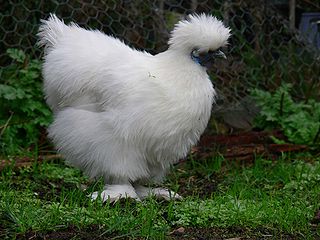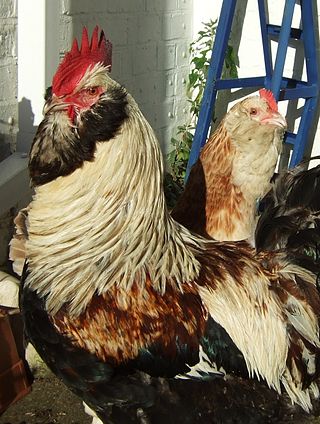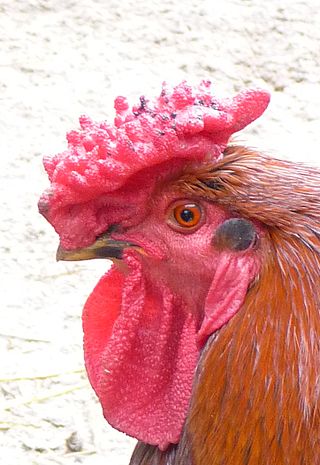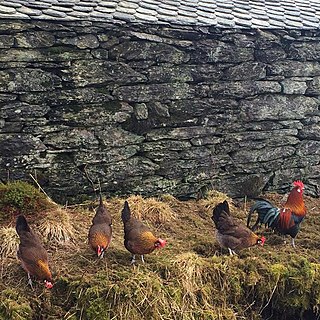
The Silkie is a breed of chicken named for its atypically fluffy plumage, which is said to feel like silk and satin. The breed has several other unusual qualities, such as black skin and bones, blue earlobes, and five toes on each foot, whereas most chickens have only four. They are often exhibited in poultry shows, and also appear in various colors. In addition to their distinctive physical characteristics, Silkies are well known for their calm and friendly temperament. It is among the most docile of poultry. Hens are also exceptionally broody, and care for young well. Although they are fair layers themselves, laying only about three eggs a week, they are commonly used to hatch eggs from other breeds and bird species due to their broody nature. Silkie chickens have been bred to have a wide variety of colors which include but are not limited to: Black, Blue, Buff, Partridge, Splash, White, Lavender, Paint and Porcelain.

The Leghorn, Italian: Livorno or Livornese, is a breed of chicken originating in Tuscany, in central Italy. Birds were first exported to North America in 1828 from the Tuscan port city of Livorno, on the western coast of Italy. They were initially called "Italians", but by 1865 the breed was known as "Leghorn", the traditional anglicisation of "Livorno". The breed was introduced to Britain from the United States in 1870. White Leghorns are commonly used as layer chickens in many countries of the world. Other Leghorn varieties are less common.

The Dorking is a British breed of domestic chicken. It is named after the town of Dorking, in Surrey in southern England.

The Brahma is an American breed of chicken. It was bred in the United States from birds imported from the Chinese port of Shanghai, and was the principal American meat breed from the 1850s until about 1930.

The Sussex is a British breed of dual-purpose chicken, reared both for its meat and for its eggs. Eight colours are recognised for both standard-sized and bantam fowl. A breed association, the Sussex Breed Club, was organised in 1903.

The Ancona is a breed of chicken which originated in the Marches, region of Italy, but which was bred to its present type mainly in the United Kingdom in the nineteenth century. It is named after the city of Ancona, capital of the Marche. It is popular in Britain and the United States, but uncommon in Italy; an initiative to re-establish it in its native area and preserve its biodiversity was launched in 2000. There are also Ancona bantams.
The Croad Langshan is an old, heavy, soft-feathered chicken breed which probably originated in China.

The New Hampshire Red or New Hampshire is an American breed of chicken. It was developed in the early twentieth century in the state of New Hampshire by selective breeding of Rhode Island Red stock; no other breed was involved. It is fast-growing, early-maturing, quick-feathering, and yields a meaty carcass. Mature birds are a light or medium red in color; they may fade in sunlight.

The Norfolk Grey is a utility breed of chicken that originated near the city of Norwich, in Norfolk, England, in around 1910. The breed was originally created by Frederick W Myhill of Hethel, Wymondham under the name Black Maria. It is a rare breed which is currently considered to be at risk by the Rare Breeds Survival Trust.

The Houdan or Poule de Houdan is an old French breed of domestic chicken. It is named for its area of origin, the commune of Houdan, in the département of Yvelines to the west of Paris. It belongs to the crested chicken group, is muffed and bearded, has an unusual leaf-shaped comb, and has five toes on each foot rather than the usual four.

The Faverolles is a French breed of chicken. The breed was developed in the 1860s in north-central France, in the vicinity of the villages of Houdan and Faverolles. The breed was given the name of the latter village and the singular is thus also Faverolles, not Faverolle. The final "s" is silent in French.
The Iowa Blue is a breed of chicken that originated near Decorah, Iowa, in the early twentieth century. Despite its name, the breed is not actually blue according to poultry standards. It is an exceedingly rare fowl, and is not recognized for showing by the American Poultry Association. They are a dual-purpose breed laying brown eggs and known to be good foragers.

The Derbyshire Redcap is a breed of chicken originating in the English county of Derbyshire. The name "Redcap" derives from the breed's unusually large Rose-type comb. British breed standards dictate a length of more than 7 centimetres (3 inches) of length for a Redcap comb. It is covered in small, fleshy points, and has a distinct spike pointing backwards called a "leader". Combs, wattles and earlobes are all ideally bright red.

The Scots Grey is a dual-purpose breed of domestic chicken originating in Scotland, where it has been bred for more than two hundred years. It was formerly known as the Scotch Grey and until about 1930 was popular in Scotland. It is on the "Native Poultry Breeds at Risk" list of the Rare Breeds Survival Trust.

The Ayam Cemani is a rare breed of chicken from Indonesia. They have a dominant gene that causes hyperpigmentation (fibromelanosis), making the chicken mostly black, including feathers, beak, and internal organs. The Cemani is a very popular gamecock for cockfighting in Bali because their thighs have much more muscle compared to other chickens, which leads to them being much faster.
The Ermellinata di Rovigo is a modern Italian breed of dual-purpose chicken. It originates in the city of Rovigo in the Veneto region of north-eastern Italy, from which it takes its name. It was created between 1959 and 1965, principally from Sussex and Rhode Island Red parentage.
The Kuroiler is a hybrid breed of chicken developed by the Keggfarms Group in Gurgaon, Haryana. Kuroilers are derived from crossing either coloured broiler males with Rhode Island Red females, or, White Leghorn males crossed with female Rhode Island Reds.
Vanaraja is a dual-purpose chicken variety developed by the ICAR-Directorate of Poultry Research in Hyderabad, India. Vanaraja is aimed a rural communities where it can be reared in backyard on natural, scavenged food with minimal supplementation. It produces eggs and meat based on rearing and feeding practices. Important features of this breed are multi-color feather pattern, immunity to disease, perform with less nutrition, grow faster and produce more eggs, produce brown eggs like local hens.

The Danish hen is a chicken landrace native to Denmark. It is the only true native chicken landrace in the country and perhaps in all of Europe.
Prelux are commercial chicken crossbreeds of the Slovenian origin, that are being sold under the eponymous trademark by the Biotechnical Faculty of University of Ljubljana. The name is an abbreviation for the Slovenian phrase prevojski luxuriranci, with a word luxuriranci referring to luxuriance (heterosis) or outbreeding enhancement of hybrid offspring, and adjective prevojski referring to the Slovenian settlement Prevoje, where selective breeding was once performed. This name was given to quality layer hens, that are being obtained by crossbreeding three Slovenian traditional breeds of layer hens; Slovenian Barred, Slovenian Brown and Slovenian Silver Hen. The most known and best-selling layer hens of the trademark Prelux are Prelux-Č, Prelux-G and Prelux-R. A part of the selection is also a meat type chicken (broiler), Prelux-BRO.














